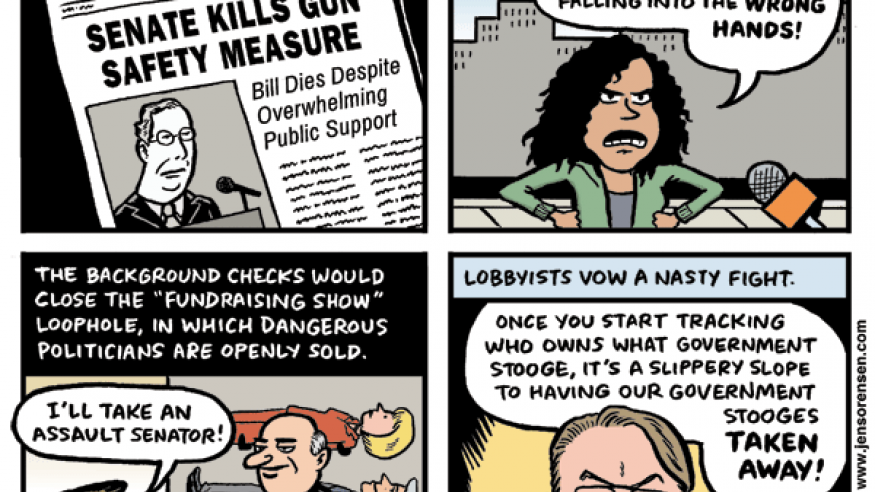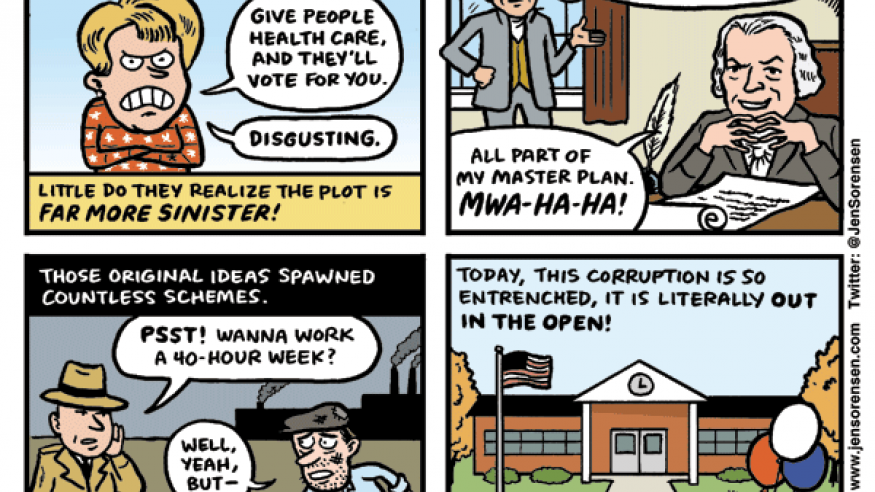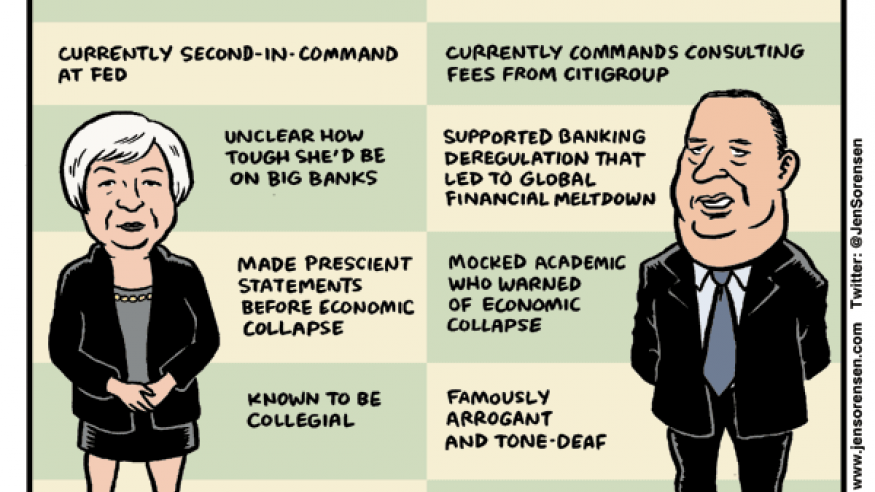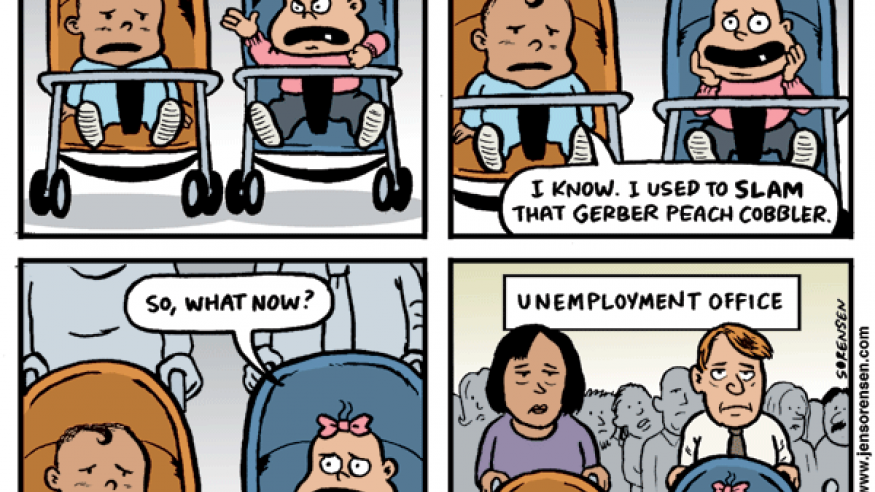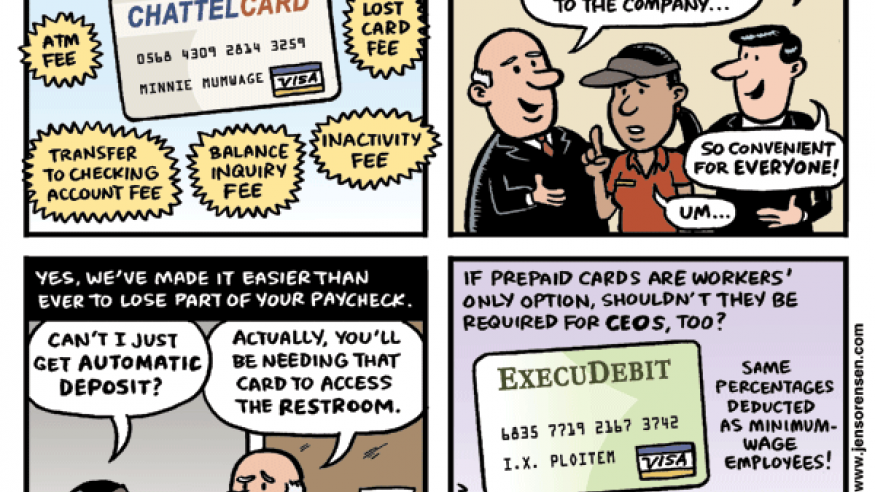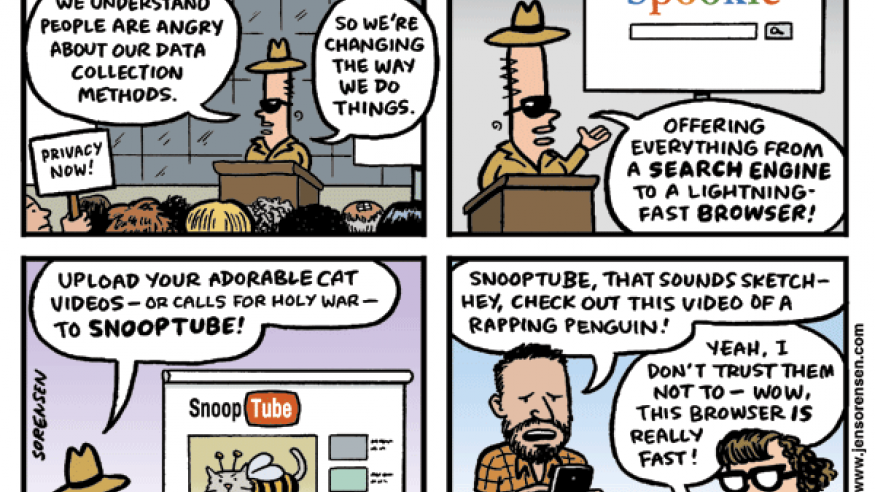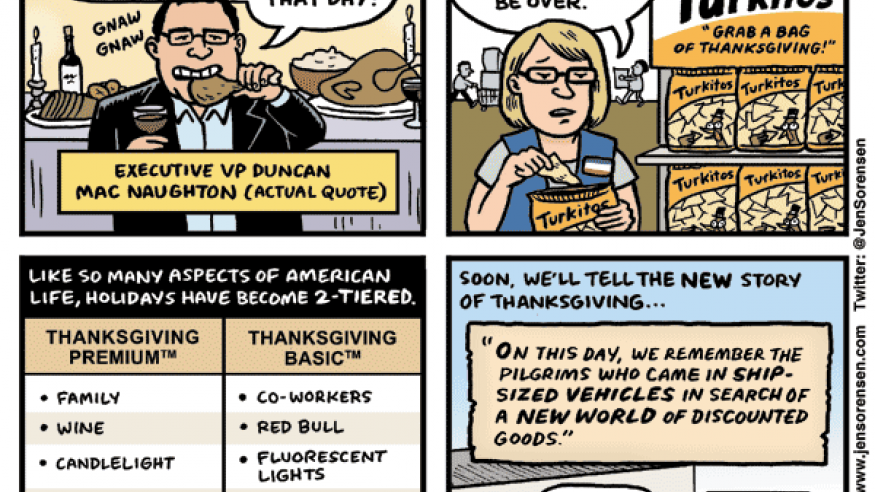Sorensen's HERBLOCK SPEECH - 4/29/2014
Thanks so much to Marci, Sarah, the judges, and the Herblock Foundation for this incredible honor. Between this award and the fact that I actually have decent health insurance now, drawing cartoons for a living doesn’t seem so crazy after all.
I actually owe double thanks – as Marci mentioned, two years ago I was the Herblock Prize Finalist, which came with a $5,000 award. That means at this moment in time, I have the unique distinction of being the cartoonist who has soaked the Herblock Foundation the most since they began doing this. So I have a lot to be grateful for.
These windfalls over the past couple years have helped me worry a little less about my career and my finances, and focus on the job I do best… which is worrying about how humanity is destroying itself. So, once again, thanks.
Another benefit of winning the Herblock is that you get to pretend you’re Truman Capote inviting people to the Black and White Ball. The Herblock documentary was called “The Black and the White,” so it’s not very much of a stretch. If you don’t know the story, Capote threw a lavish party in 1966 in honor of Washington Post publisher Katherine Graham, although it could be argued that it was more in honor of himself. Getting invited to the Black and White Ball was the ultimate social compliment. So, congratulations to all of you for being here tonight!
Now, unlike Capote, I fortunately don’t have to pay for this. But I do have some guests of honor I’d like to mention.
My parents John and Linda are here tonight, and I’m so glad they could make it. They actually got engaged not far from here, at the base of the Washington Monument, one freezing cold night in 1966. That’s also where I happened to stand while I watched the inauguration of Barack Obama on a jumbotron one freezing cold day in 2009.
My parents raised me a couple hours north of here, in Lancaster County, PA, where I had a happy childhood filled with comic books and art supplies. My parents have always encouraged my cartooning habit, and have patiently endured some of my more inconvenient deadlines during holidays and family visits over the years. So thanks for everything, Mom and Dad.
My husband Scott is also here with me tonight. Scott is my cartoon editor, political conversation partner, and best friend. We met at the University of Virginia – having this event in the Thomas Jefferson Building feels eerily appropriate, by the way – and he wooed me with his cartoon book collection. Feel free to take that as dating advice, all you singles out there. Scott, thanks for all you’ve done.
My last guest of honor is the editor who gave me my start, Cathy Harding. Cathy was the editor of C-VILLE Weekly in Charlottesville, Virginia for many years. In 2002, I had been published a couple places, but not yet in my local altweekly. Cathy agreed to meet me in person in her office, and to my amazement, she offered me a spot in the paper. She’s gone beyond the call of duty to help me out over the years. So, cheers to Cathy.
If you look at my life in a nutshell, I grew up the daughter of public schoolteachers, watched a lot of public television – I was into Sesame Street and The Electric Company – went to public schools, attended a great public university, and later worked as a public employee while I started a career drawing cartoons about the public good. In other words, I’m Ayn Rand’s worst nightmare. But I like to think I turned out OK.
My cartoons are in the multi-paneled, so-called “alternative” genre. I appreciate that even though Herblock drew in a traditional single-panel style, the Herblock contest has been open-minded about all forms of contemporary political cartoons.
I’m told that I happen to be the first woman to win the Herblock. I’ll do my best to represent. I feel a kinship with Janet Yellen, who was appointed the first woman to chair the Federal Reserve, after being preceded by 14 dudes. I only had to wait for 10, and Tom Toles didn’t pull an Alan Greenspan and lock it up for 20 years.
To be fair, 1 in 10 is probably an accurate ratio when it comes to political cartoonists, and even that might be a little generous. I thought I’d talk about that tonight, since I get asked about it a lot, and in the future I can just point people to the Youtube video of this speech.
Six years ago, CampusProgress.org, now Generation Progress, asked me to write an essay about why there are so few female political cartoonists. I attributed the disparity to lack of historical precedent; after all, the Mad Men era wasn’t that long ago.
I’ve rarely encountered any overt sexism in my career. My male colleagues, some of whom are here tonight, have been tremendously supportive, helping me “lean in” long before that was a thing. In fact, my friend Clay Bennett, this year’s Finalist, is the person who asked me to join the AAEC.
But since then, I’ve become increasingly troubled by certain observations about the media. If you look at the regular New York Times op-ed columnists – today, in 2014 – there are 2 women and 10 men. 2 to 10! Maybe political cartooning has a limited history of female role models, but last I heard, there was no shortage of women with strong opinions who can write.
And look at what’s happened with the shake-up in late night talk shows. Jimmy Fallon and Tina Fey used to host Saturday Night Live’s “Weekend Update” – guess which one is now hosting the Tonight Show? Seth Meyers and Amy Poehler also hosted Weekend Update. Guess who filled the 12:30 slot? David Letterman is being replaced by Stephen Colbert, who I like a lot, but I can’t help but sense a pattern.
Recently I learned that only one of the individual Pulitzer Prize winners in Journalism this year was female.
There is something going on here, and it’s more subtle than Don Draper. The media landscape consists of a bunch of roles waiting to be filled, and we as a society have certain expectations about what the people who fill those roles look like. I can’t tell you how many times I’ve had readers tell me they assumed I was a guy, apparently some Scandinavian expat named Jens Sorensen.
To some extent, I think women in media are up against a sort of dude-to-dude magnetism. Some guys just feel more comfortable talking to and collaborating with other guys. But I think the bigger problem lies in all of us – men and women – in ways we aren’t even conscious of. Even the most equality-minded among us have internalized these cultural norms. We could all take a step forward through greater self-awareness. By asking ourselves whose voices we’re elevating; by asking who we’re inviting to be on panels, who we’re interviewing for articles, who we are retweeting and why. And by locking up the menfolk. (Just kidding.)
This all reminds me of my friend Keith Knight, creator of the Knight Life and the K Chronicles. When he was getting started, he would get most of his freelance assignments during Black History month. So he started telling editors, “You know, I’m available to work the rest of the year too!”
Interestingly, there are some fairly prominent female editorial cartoonists in other countries – places you might not expect. I had the pleasure of meeting Doaa al Edl, a well-known cartoonist in Egypt, when she was on a State Department-sponsored tour of the U.S. just after the Arab Spring uprisings. She came up to me after an event in Portland, Oregon, excited to meet another of her kind, and gave me a cool little scarab paperweight that she’d brought all the way from Egypt. It’s one of my prized possessions.
The year after that, Doaa had an unpleasant encounter with the Morsi regime, which charged her with blasphemy for depicting Adam and Eve in a cartoon. She and the publisher of her newspaper were sued, and her life was threatened. Fortunately, with the ouster of that government, her situation has improved.
Other political cartoonists around the globe have not been so lucky. Last fall we heard reports that Syrian cartoonist Akram Raslan had been executed by the Assad regime, of whom he had been critical, although there is still some uncertainty about his status.
I may get upset by American politics on a daily basis, but I am grateful for the freedom of expression that I enjoy here. To help our colleagues abroad who don’t have the same protections, there is a non-profit based here in the DC area called Cartoonists Rights Network International. The director, Bro Russell, is here tonight, and I encourage you to seek him out and learn more about what that great organization is doing.
Speaking of champions of good causes, I’d like to say a few words about Herblock, who I unfortunately never met. I was reading him regularly toward the end of his career, when I lived in Virginia and subscribed to the Post. That was a period of political turmoil – the Bush vs. Gore presidential race, the Florida recount, and the Supreme Court decision giving Bush the presidency. It was a formative period for me, pushing my work in a more political direction. I found myself taking comfort in Herblock’s cartoons, and cheering him on through those dark days. And when he disappeared from the op-ed page in August of 2001, to me it felt like the last straw, like the world was coming to an end.
As I’ve noted before, what I admired most about Herblock was that he drew from a clear moral perspective. He didn’t just illustrate the news or go for innocuous, crowd-pleasing Jay Leno-style gags. He didn’t take the uncontroversial path of false equivalence. You knew where he stood. He seemed to intuitively grasp that meeting insanity halfway meant you were halfway to insanity. And by following his moral compass, how often he was on the right side of history!
To me, that’s what political cartooning is all about. That’s why I think of it as the Noble Art. Although I am mystified as to why there seems to be something of a media blackout around the people behind the cartoons. You see obscure academics and authors plugging their books on TV all the time. Op-ed columnists get invited to be talking heads on cable news. You know it’s bad when you’re considered beneath the standards of cable.
For some reason, if you deal in words, you’re a serious thinker, but if you deal in words AND pictures, you’re something between a court jester and a street busker. I remember once seeing an altweekly that put its comics, including at least one political cartoon, under the section heading “Fluff.”
So I am grateful to Herblock’s legacy as well as the Library of Congress for reaffirming that we aren’t fluff, for recognizing political cartooning as an art form worthy of this magnificent space, and for giving the medium the respect that it deserves. Thank you.
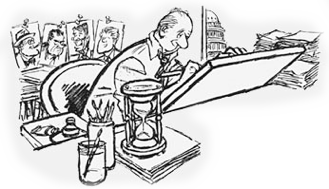 Herb Block is among the world’s best known and most admired political cartoonists. Born on October 13, 1909, the native Chicagoan spent his 72-year career fighting against abuses of the powerful.
Herb Block is among the world’s best known and most admired political cartoonists. Born on October 13, 1909, the native Chicagoan spent his 72-year career fighting against abuses of the powerful.


